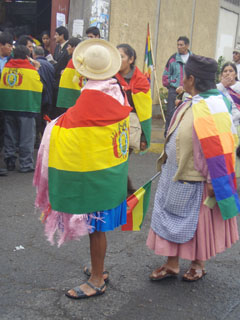
(above) New constitution backs indigenous autonomy. (Photo: William Chico)
Indigenous autonomy finally a reality?
February 5, 2009 - LatinAmerica Press
Martin Garat
New constitution protects indigenous self-determination.
Bolivia´s recently-approved constitution is a milestone for Bolivia. Approved in a popular referendum on Jan. 25, the charter is the country´s first that creates autonomous indigenous territories that will carry the same weight as departments, or states.
“Native indigenous-campesina autonomy consists of the self-governance, such as the free determination of native indigenous [or] campesino peoples, whose population shares land, culture, history, languages, and their own legal, political, social and economic organization or institutions,” states Article 289 of the constitution.
But this is not a new concept, at least to Bolivia´s indigenous population, says anthropologist Jorge Riester from Support for the Indigenous-Campesino of the Bolivia Orient organization.
“Autonomy is not an invention of the current government,” he said. “The indigenous have always considered that they have the right to self-determination, despite the fact that for a time in history they were exploited and discriminated against.”
Indigenous lands will be outlined by the Native Communal Land legislations. In 1996, a law established that these indigenous lands would be collectively held by the community and could not be sold. Under the new constitution, the residents on these lands will be able to request autonomy. Under the Native Communal Land regulation, some indigenous autonomy has already been granted, such as the election of authorities using native customs and processes.
Indigenous autonomy is a strengthening of the right “to decide what to do with their land, to participate with voice and vote on their development visions and to do business with their natural resources in a most just way” if it does not violate the constitution, Riester said.
Resource management
According to the new constitution, autonomous indigenous governments can administrate natural resources found on their lands including, medicinal plants, trees and soil, among others. The state will continue controlling hydrocarbons fields, however, including those found on indigenous lands.
Miguel Ipamo runs the indigenous land management arm of the Confederation of Indigenous Peoples of Bolivia, an umbrella group of eastern Bolivian indigenous population. Ipamo, a member of the Chiquitano people of eastern Bolivia, and a longtime indigenous activist, works to improve the structure of the Native Communal Land regulations.
“The [autonomy] proposal is ours, not the Movement to Socialism´s,” Ipamo said, referring to President Evo Morales’ political party. “We wrote it and we put it in the constitution through the ruling party.”
The state will have to provide funds to the autonomous indigenous communities. But the generation of their own income is important, Ipamo said.
“It can´t be autonomy with someone else´s money,” he said. “Autonomy is made, managed and articulated from inside. That´s why it´s important for us to generate income on our own territory, but without degrading the land.”
Many indigenous lands are rich in timber, a possible development alternative being considered on indigenous lands. Self-determination´s affect on health and education are also key issues.
“We use medicinal plants, which are also used in scientific medicine. We get them naturally, which is, cheaper and more fresh,” Ipamo said. “When it is necessary we combine them with scientific medicines, with pills and other remedies.”
He added that there are always new lesson plans in the works for their schools.
“First of all, the children are going to learn who we are and they are going to learn our languages. Then we will incorporate the region, the country and the rest of the world.”
Gender equality is pressing issue. “Women need to be equal to men,” Ipamo said. “Now, women are also leaders, give their opinions and suggestions.”
He said that the autonomy will help strengthen processes that were already underway under the 1996 indigenous land legislation.
Risks and challenges
Some indigenous organizations are still week, which poses a threat to autonomy, in terms of how decisions are made and assigning responsibilities in the community.
Many of Bolivia´s 36 indigenous peoples are small communities with fewer than 1,000 members. Ipamo said that the creation of an autonomous community should have a minimal population of 5,000 people. This would force small or isolated indigenous communities to merge with other peoples, which would make it hard to reach a consensus.
Riester said that indigenous communities may need technical assistance, which he calls “professionalization” to help them self-govern.
“One of the main problems is that there still isn´t a sufficient number of indigenous professionals for the adequate management of their resources. But it´s not the indigenous´ fault. They have always been excluded from education,” he said.
Job training also implies risks, such as having young indigenous community members deserting their homelands to study in urban centers. Even if citizens have the right to live where they would like, in order to avoid the “escape of the minds” special measures must be put into place, to keep the community present with them, even when they leave.
—Latinamerica Press.